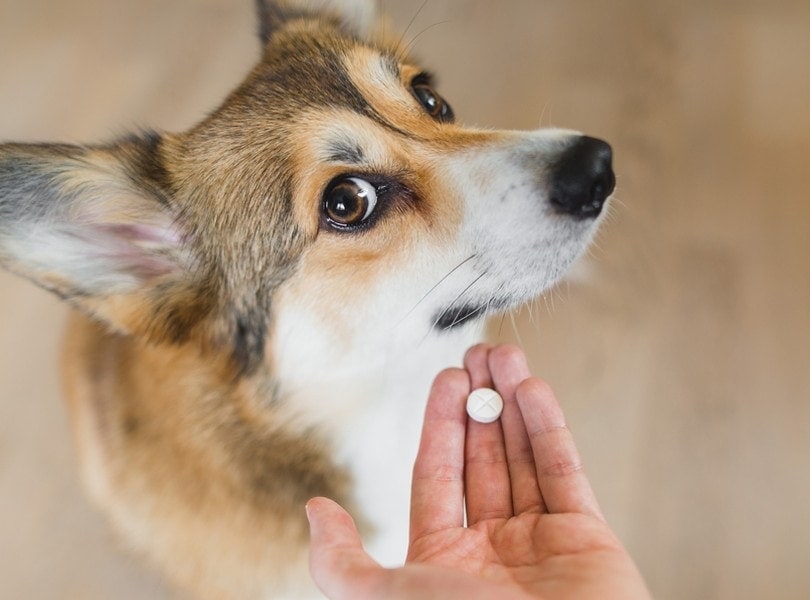Melatonin has become popular as a sleep aid for people who suffer from insomnia or jet lag. It is used in dogs to treat anxiety disorders such as separation anxiety and noise phobias. Older dogs with disrupted sleep patterns caused by canine cognitive dysfunction (also known as “dog dementia”) may also benefit from melatonin supplementation. Melatonin may also be used to treat certain conditions that cause non-allergic hair loss. However, that doesn’t mean melatonin is good for all dogs, especially if taken in large quantities. As with most things in life, it is possible to get too much of a good thing and melatonin is no exception.
If your pup has accidentally ingested melatonin, don’t panic! Here’s what to do:
What are the signs of a melatonin overdose in dogs?

First, how do you know your dog has eaten melatonin?
A mild overdose is unlikely to cause serious issues. Your dog may vomit and develop diarrhea and become sleepy due to melatonin’s sedative effect. Symptoms usually appear within 20 to 30 minutes. Although a large overdose is unlikely to result in death, it can result in more serious symptoms that require urgent veterinary attention. Signs of a large overdose of melatonin may include vomiting and diarrhea, incoordination and drowsiness, itchiness, high blood pressure, a fast heart rate and seizures.
What should I do if I discover that my dog has eaten melatonin?
Before phoning your local veterinarian or pet poison helpline, remove any uneaten melatonin so that your dog and other animals in the house cannot eat any more.
Don’t try to make your dog vomit without the consent or instruction of your veterinarian. Inducing vomiting can be dangerous if your dog is drowsy or unconscious and may result in them choking or inhaling their own vomit.
Try to determine the amount of melatonin that your dog has eaten. The label on the bottle should state the amount of melatonin contained per tablet, chew, or capsule. Multiply this by the amount of melatonin missing to get an estimate of the dose that your dog has eaten. The more information you have, the better the advice that your veterinarian or poison control helpline operator will be able to give you. Don’t worry if it’s not possible to do this.
Try to work out the time at which your dog ate melatonin. Take note if your pet is currently showing any signs of an overdose. Symptoms start to show roughly 20 to 30 minutes after ingestion.
Check the label on the melatonin bottle and determine if there are any other ingredients included such as xylitol. As previously mentioned, many human grade melatonin products contain this artificial sweetener. If your dog ingests xylitol, this is a true medical emergency, and your dog should be rushed to the closest veterinary clinic as soon as possible.
Call your local veterinarian or pet poison helpline. Depending on the dose of melatonin that your dog ate as well as whether it contains any harmful additives, you may be advised to take your dog to your local veterinarian. If it has been less than two hours since ingestion, your vet may induce vomiting. Your vet may also want to hospitalize your dog for observation and for treatment of any side effects that may arise from the melatonin overdose.
What exactly is melatonin?
https://www.instagram.com/p/CQ47KfRBWkg/
Melatonin is a hormone produced primarily by the pineal gland. This naturally occurring hormone helps regulate the sleep-wake cycle in both humans and animals.
Melatonin levels rise in the evening in response to darkness. At nighttime, melatonin levels are up to ten times higher than during the day. The increase in melatonin brings about a feeling of calm and signals to the body that it is time for sleep.
Melatonin also influences reproductive cycles, especially in animals that are seasonal breeders.
Does that mean that it’s safe for me to give my dog melatonin?
Melatonin is generally considered to be safe and under the right circumstances it may be beneficial to your dog. However, there are circumstances under which it should not be used.
Pregnant or nursing dogs should not be given melatonin, nor should puppies under the age of 3 months. Melatonin is metabolized by the liver, and it should therefore be used with caution in dogs with liver dysfunction. It should also be used with caution in dogs with kidney impairment as well as in patients with a history of neurological disorders due to its central nervous system depressant qualities.
Melatonin can also negatively interact with some drugs. If your pet is receiving medication for anxiety, melatonin may cause an increase in side effects such as drowsiness.
It’s a good idea to always check with your veterinarian before starting treatment. Your vet can advise whether or not your dog can benefit from treatment.
It is critical to note that many human grade melatonin products include herbs that are toxic to dogs. They can also contain sweeteners such as xylitol, which is highly toxic to dogs. More on that topic later in the article.
What dose of melatonin should my dog get?
The dose of melatonin is dependent on the condition being treated as well as the size of your dog. The dose for oral supplementation for dogs struggling with sleep or anxiety issues is anywhere between 1 to 6 mg per dog given every 8 to 12 hours.
- Dogs weighing less than 10 pounds: 1 mg
- Dogs weighing between 10 to 25 pounds: 1.5 mg
- Dogs weighing between 26 to 100 pounds: 3 mg
- Dogs weighing more than 100 pounds: 3 to 6 mg
When treating conditions such as hair loss in dogs, your veterinarian may choose to use a melatonin implant that is inserted just under your dog’s skin.

What is xylitol and why is it so bad for dogs?
Xylitol is a low-calorie artificial sweetener that has gained popularity in recent years. It is commonly used as a sugar substitute in things like gum, candies, peanut butter and other baked foods and medicine. Xylitol causes the rapid release of insulin in dogs, followed by a sharp decrease in their blood sugar levels resulting in hypoglycemia or low blood sugar. Xylitol can also cause liver failure and death in dogs. Effects can occur within 30 to 60 minutes after ingestion so immediate veterinary attention is crucial. If left untreated, xylitol poisoning can be life-threatening.
The initial signs of a xylitol overdose may include vomiting, weakness, seizures, and collapse. These signs are due to low blood sugar. Even though some dogs do not show symptoms initially, they can still go on to develop liver failure at a later stage. Therefore, veterinary attention is crucial even if your dog is not showing symptoms.
In summary
Melatonin is generally considered to be a safe drug if given at the correct dose. However, not all dogs are suitable candidates for treatment with melatonin. Always consult your veterinarian before giving your dog melatonin and only use melatonin supplements specifically formulated for dogs. As with all medication, melatonin should be stored out of reach of animals.
Featured Image Credit: photo_gonzo, Shutterstock
Contents









